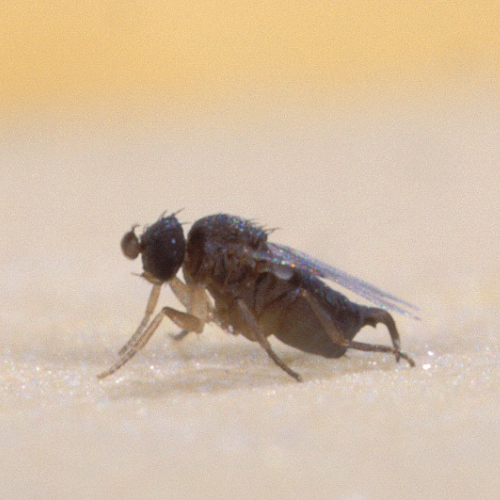Phorid Fly

Proud Supporter of Disabled Veterans
No Contracts
Services provided without written contracts.
Introduction to
Phorid flies, also known as humpbacked flies, are small insects that can become a significant nuisance in homes and commercial buildings. Scientifically known as Phoridae, these flies are easily recognized by their distinctive humpbacked appearance and erratic flight patterns. They are often associated with decaying organic matter, making them common in places with poor sanitation. Understanding the biology, habits, and effective prevention methods for phorid flies is crucial for managing infestations and maintaining a clean and hygienic environment.
Recognition
Phorid flies are small, typically measuring 1/16 to 1/8 inch (1.5 to 3 mm) in length. They have a dark brown to black body with a distinctive humpbacked appearance due to their arched thorax. Their wings are clear, and they exhibit a characteristic erratic, short-burst flight pattern. Phorid flies are often mistaken for fruit flies, but they lack the red eyes and are more robust in appearance. They can also be confused with drain flies, but phorid flies are less hairy and more streamlined.
Biology
Phorid flies undergo complete metamorphosis, progressing through four life stages: egg, larva, pupa, and adult. Females lay their eggs on decaying organic matter, where the larvae hatch and feed. The larvae are small, legless, and cream-colored, thriving in moist environments with abundant organic material. After feeding for several days to weeks, the larvae pupate in a dry location near the breeding site. Adult phorid flies emerge from the pupae and can live for several weeks, during which time they reproduce and lay more eggs. Their lifecycle can be completed in as little as 14 days under optimal conditions.
Habits
Phorid flies prefer moist, decaying organic matter as their breeding sites. They are commonly found in drains, garbage disposals, compost bins, and areas with sewage leaks. Indoors, they are often seen in kitchens, bathrooms, and basements. Phorid flies are attracted to decaying food, organic waste, and other moist, decomposing materials. They can also infest the soil of potted plants if it is kept too moist. These flies are most active during the day and are known for their erratic flying patterns.
Prevention
Preventing phorid fly infestations involves maintaining good sanitation and eliminating breeding sites. Regularly clean and sanitize drains, garbage disposals, and compost bins to remove organic buildup. Fix any leaks and ensure proper drainage to reduce moisture levels in kitchens, bathrooms, and basements. Store food in airtight containers and promptly clean up spills and crumbs. Dispose of garbage regularly and keep trash bins covered. Avoid overwatering potted plants and ensure proper soil drainage. Using fly traps can help monitor and reduce the population of adult phorid flies.
Professional
If phorid flies become a persistent problem, professional pest control services can provide effective solutions. STL Pest Control offers comprehensive treatments to eliminate phorid fly populations from homes and commercial establishments. Their technicians are trained to identify breeding sites and apply appropriate treatments, including insecticidal sprays, microbial cleaners, and integrated pest management techniques. In severe cases, they may recommend ongoing maintenance plans to keep phorid fly populations under control. Professional services ensure thorough and long-lasting control, providing peace of mind and a cleaner living environment.



Our Office







